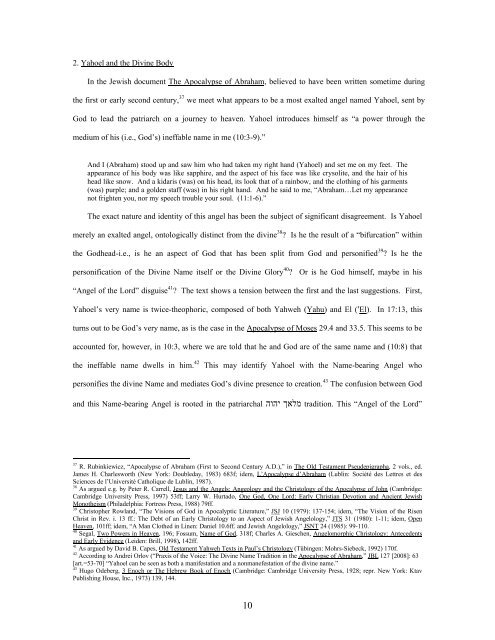Sapphiric God: - Dr. Wesley Muhammad
Sapphiric God: - Dr. Wesley Muhammad
Sapphiric God: - Dr. Wesley Muhammad
Create successful ePaper yourself
Turn your PDF publications into a flip-book with our unique Google optimized e-Paper software.
2. Yahoel and the Divine Body<br />
In the Jewish document The Apocalypse of Abraham, believed to have been written sometime during<br />
the first or early second century, 37 we meet what appears to be a most exalted angel named Yahoel, sent by<br />
<strong>God</strong> to lead the patriarch on a journey to heaven. Yahoel introduces himself as “a power through the<br />
medium of his (i.e., <strong>God</strong>’s) ineffable name in me (10:3-9).”<br />
And I (Abraham) stood up and saw him who had taken my right hand (Yahoel) and set me on my feet. The<br />
appearance of his body was like sapphire, and the aspect of his face was like crysolite, and the hair of his<br />
head like snow. And a kidaris (was) on his head, its look that of a rainbow, and the clothing of his garments<br />
(was) purple; and a golden staff (was) in his right hand. And he said to me, “Abraham…Let my appearance<br />
not frighten you, nor my speech trouble your soul. (11:1-6).”<br />
The exact nature and identity of this angel has been the subject of significant disagreement. Is Yahoel<br />
merely an exalted angel, ontologically distinct from the divine 38 ? Is he the result of a “bifurcation” within<br />
the <strong>God</strong>head-i.e., is he an aspect of <strong>God</strong> that has been split from <strong>God</strong> and personified 39 ? Is he the<br />
personification of the Divine Name itself or the Divine Glory 40 ? Or is he <strong>God</strong> himself, maybe in his<br />
“Angel of the Lord” disguise 41 ? The text shows a tension between the first and the last suggestions. First,<br />
Yahoel’s very name is twice-theophoric, composed of both Yahweh (Yahu) and El ("El). In 17:13, this<br />
turns out to be <strong>God</strong>’s very name, as is the case in the Apocalypse of Moses 29.4 and 33.5. This seems to be<br />
accounted for, however, in 10:3, where we are told that he and <strong>God</strong> are of the same name and (10:8) that<br />
the ineffable name dwells in him. 42 This may identify Yahoel with the Name-bearing Angel who<br />
personifies the divine Name and mediates <strong>God</strong>’s divine presence to creation. 43 The confusion between <strong>God</strong><br />
and this Name-bearing Angel is rooted in the patriarchal הוהי ךאלמ tradition. This “Angel of the Lord”<br />
37<br />
R. Rubinkiewicz, “Apocalypse of Abraham (First to Second Century A.D.),” in The Old Testament Pseudepigrapha, 2 vols., ed.<br />
James H. Charlesworth (New York: Doubleday, 1983) 683f; idem, L’Apocalypse d’Abraham (Lublin: Société des Lettres et des<br />
Sciences de l’Université Catholique de Lublin, 1987).<br />
38<br />
As argued e.g. by Peter R. Carrell, Jesus and the Angels: Angeology and the Christology of the Apocalypse of John (Cambridge:<br />
Cambridge University Press, 1997) 53ff; Larry W. Hurtado, One <strong>God</strong>, One Lord: Early Christian Devotion and Ancient Jewish<br />
Monotheism (Philadelphia: Fortress Press, 1988) 79ff.<br />
39<br />
Christopher Rowland, “The Visions of <strong>God</strong> in Apocalyptic Literature,” JSJ 10 (1979): 137-154; idem, “The Vision of the Risen<br />
Christ in Rev. i. 13 ff.: The Debt of an Early Christology to an Aspect of Jewish Angelology,” JTS 31 (1980): 1-11; idem, Open<br />
Heaven, 101ff; idem, “A Man Clothed in Linen: Daniel 10.6ff. and Jewish Angelology,” JSNT 24 (1985): 99-110.<br />
40<br />
Segal, Two Powers in Heaven, 196; Fossum, Name of <strong>God</strong>, 318f; Charles A. Gieschen, Angelomorphic Christology: Antecedents<br />
and Early Evidence (Leiden: Brill, 1998), 142ff.<br />
41<br />
As argued by David B. Capes, Old Testament Yahweh Texts in Paul’s Christology (Tübingen: Mohrs-Siebeck, 1992) 170f.<br />
42<br />
According to Andrei Orlov (“Praxis of the Voice: The Divine Name Tradition in the Apocalypse of Abraham,” JBL 127 [2008]: 63<br />
[art.=53-70] “Yahoel can be seen as both a manifestation and a nonmanefestation of the divine name.”<br />
43<br />
Hugo Odeberg, 3 Enoch or The Hebrew Book of Enoch (Cambridge: Cambridge University Press, 1928; repr. New York: Ktav<br />
Publishing House, Inc., 1973) 139, 144.<br />
10
















